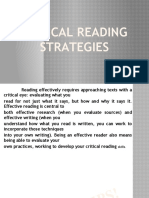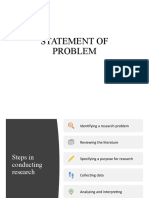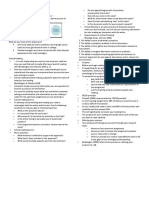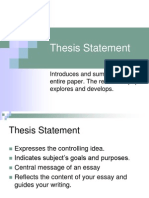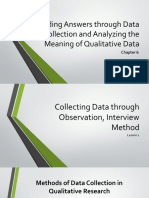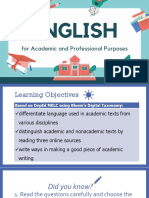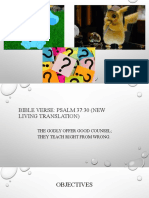100%(1)100% found this document useful (1 vote)
35 viewsCritical Reading: Analyze, Interpret and Evaluate
Critical Reading: Analyze, Interpret and Evaluate
Uploaded by
Anthony TalosigCritical reading involves analyzing, interpreting, and sometimes evaluating a text. It requires using critical thinking skills to question both the content of the text and one's own understanding of it. The purpose of critical reading is to form judgements about how a text works, rather than just getting a basic understanding of what it says. To prepare, one should reflect on their own perspectives and knowledge, understand the context and main ideas of the text, and clarify any confusing parts. The process involves analyzing the text, interpreting its meaning and significance, and evaluating aspects of it.
Copyright:
© All Rights Reserved
Available Formats
Download as PDF, TXT or read online from Scribd
Critical Reading: Analyze, Interpret and Evaluate
Critical Reading: Analyze, Interpret and Evaluate
Uploaded by
Anthony Talosig100%(1)100% found this document useful (1 vote)
35 views5 pagesCritical reading involves analyzing, interpreting, and sometimes evaluating a text. It requires using critical thinking skills to question both the content of the text and one's own understanding of it. The purpose of critical reading is to form judgements about how a text works, rather than just getting a basic understanding of what it says. To prepare, one should reflect on their own perspectives and knowledge, understand the context and main ideas of the text, and clarify any confusing parts. The process involves analyzing the text, interpreting its meaning and significance, and evaluating aspects of it.
Original Title
Presentation
Copyright
© © All Rights Reserved
Available Formats
PDF, TXT or read online from Scribd
Share this document
Did you find this document useful?
Is this content inappropriate?
Critical reading involves analyzing, interpreting, and sometimes evaluating a text. It requires using critical thinking skills to question both the content of the text and one's own understanding of it. The purpose of critical reading is to form judgements about how a text works, rather than just getting a basic understanding of what it says. To prepare, one should reflect on their own perspectives and knowledge, understand the context and main ideas of the text, and clarify any confusing parts. The process involves analyzing the text, interpreting its meaning and significance, and evaluating aspects of it.
Copyright:
© All Rights Reserved
Available Formats
Download as PDF, TXT or read online from Scribd
Download as pdf or txt
100%(1)100% found this document useful (1 vote)
35 views5 pagesCritical Reading: Analyze, Interpret and Evaluate
Critical Reading: Analyze, Interpret and Evaluate
Uploaded by
Anthony TalosigCritical reading involves analyzing, interpreting, and sometimes evaluating a text. It requires using critical thinking skills to question both the content of the text and one's own understanding of it. The purpose of critical reading is to form judgements about how a text works, rather than just getting a basic understanding of what it says. To prepare, one should reflect on their own perspectives and knowledge, understand the context and main ideas of the text, and clarify any confusing parts. The process involves analyzing the text, interpreting its meaning and significance, and evaluating aspects of it.
Copyright:
© All Rights Reserved
Available Formats
Download as PDF, TXT or read online from Scribd
Download as pdf or txt
You are on page 1of 5
CRITICAL READING
Analyze, Interpret and Evaluate
READING CRITICALLY
• Critical reading is a process of analyzing, interpreting and, sometimes,
evaluating. When we read critically, we use our critical thinking skills to
QUESTION both the text and our own reading of it. Different disciplines
may have distinctive modes of critical reading (scientific, philosophical,
literary, etc).
Difference Between READING and
CRITICAL READING
Reading Critical Reading
Purpose To get a basic grasp of a text. To form judgements about
How a text works.
Activity Absorbing/Understanding Analyzing, Interpreting and
Evaluating
Focus What a text SAYS What a text DOES and MEANS
WHAT NEEDS TO BE DONE TO
PREPARE FOR CRITICAL READING?
• Self-Reflect : • Read to Understand :
What experiences, assumptions, a. Examine the text and context: Who is
knowledge, and perspectives do you bring the author?
to the text
b. Skim the text: What is the topic? What
are the main ideas?
c. Resolve confusion: Look up unfamiliar
words or terms in dictionaries or
glossaries. Go over
difficult passages to clarify them.
WHAT IS THE PROCESS FOR READING
CRITICALLY?
• To read critically, you must think critically. This involves analysis,
interpretation, and evaluation. Each of these processes helps you to interact
with the text in different ways:
You might also like
- 21st Century-1-Lesson-PlanDocument4 pages21st Century-1-Lesson-PlanJune Delfino DeluteNo ratings yet
- CRITICAL READING - WPS OfficeDocument28 pagesCRITICAL READING - WPS OfficefrezelenrubioNo ratings yet
- Critical Reading StrategiesDocument20 pagesCritical Reading StrategiesRiza VillariasNo ratings yet
- Critical Reading As Looking For Ways ofDocument29 pagesCritical Reading As Looking For Ways ofJaymark LamesaNo ratings yet
- Daily Lesson Plan Understanding by DesignDocument5 pagesDaily Lesson Plan Understanding by Designapi-446537912No ratings yet
- Critical Reading Strategies DLPDocument1 pageCritical Reading Strategies DLPCopas Marie EllengridNo ratings yet
- Research TitleDocument3 pagesResearch TitleMelissa100% (1)
- Pronoun: DefinitionDocument8 pagesPronoun: DefinitionRegiena AnicieteNo ratings yet
- Reaction Critique Review Paper Module3Document69 pagesReaction Critique Review Paper Module3SOPHIA LEENE LALAGUNANo ratings yet
- Research Title Proposal RubricsDocument2 pagesResearch Title Proposal RubricsEdvard Yves SanapoNo ratings yet
- Statement of ProblemDocument25 pagesStatement of ProblemNabila HanisNo ratings yet
- BrianQualities of A Good ParagraphDocument8 pagesBrianQualities of A Good ParagraphRommel St John0% (1)
- Module 2Document11 pagesModule 2Nicholas EssandohNo ratings yet
- Final Research in Daily Life 1Document11 pagesFinal Research in Daily Life 1inah krizia lagueNo ratings yet
- Distinguish The Features of Academic WritingDocument40 pagesDistinguish The Features of Academic WritingShanelle May G. CasabuenaNo ratings yet
- Practical Research 2: Schools Division of Bohol: 4: 7: 7Document2 pagesPractical Research 2: Schools Division of Bohol: 4: 7: 7Jown Honenew Lpt0% (1)
- Reading and Writing Lesson 2Document1 pageReading and Writing Lesson 2Joshua Lander Soquita CadayonaNo ratings yet
- Book Review or Article CritiqueDocument25 pagesBook Review or Article Critiquehannah angelNo ratings yet
- Types of ArgumentsDocument9 pagesTypes of ArgumentsAkshat SinghNo ratings yet
- Synthesis Matrix TemplateDocument1 pageSynthesis Matrix TemplatesNo ratings yet
- Anao High School (Senior High)Document5 pagesAnao High School (Senior High)JulieAnnLucasBagamaspadNo ratings yet
- DLL - 4th QRTR - Week 1Document6 pagesDLL - 4th QRTR - Week 1Jaycelyn BaduaNo ratings yet
- Worksheet - Reliability, Validity, and NormsDocument3 pagesWorksheet - Reliability, Validity, and NormsRHIZZA MAE BONGHANOY HITOSISNo ratings yet
- Lesson 8 Purposeful Writing in The Disciplines: What Is A Book Review or Article Critique?Document20 pagesLesson 8 Purposeful Writing in The Disciplines: What Is A Book Review or Article Critique?Charles Jade Rubang GalimbaNo ratings yet
- Critical ReadingDocument1 pageCritical ReadingklrxxNo ratings yet
- Module in Reading and Writing Q2-Q4 Week 3Document12 pagesModule in Reading and Writing Q2-Q4 Week 3Krizia Bregania100% (1)
- Module 3 - How To Write An IntroductionDocument7 pagesModule 3 - How To Write An Introductionmarvin pazNo ratings yet
- Rubrics For CHAPTER1Document1 pageRubrics For CHAPTER1Maria Liza CuetoNo ratings yet
- Dok For WritingDocument3 pagesDok For Writingapi-242128584No ratings yet
- LAS English G10 Q4 MELC1Document8 pagesLAS English G10 Q4 MELC1Althea CuliNo ratings yet
- Investigatory Project RubricDocument3 pagesInvestigatory Project RubricRovic DiazNo ratings yet
- Principles of AssessmentDocument2 pagesPrinciples of AssessmentthirithaNo ratings yet
- Writing The RRLDocument15 pagesWriting The RRLIanne FabianNo ratings yet
- Layout For Research ReportDocument3 pagesLayout For Research ReportHazur SaranNo ratings yet
- Paragraph WritingDocument14 pagesParagraph WritingSolomon BefrduNo ratings yet
- Ethical Standards in Conducting A Research: HonestyDocument3 pagesEthical Standards in Conducting A Research: HonestyKate Angeline De SagunNo ratings yet
- MemoDocument82 pagesMemoRamna RizwanNo ratings yet
- Lesson 2 Locating Main IdeasDocument22 pagesLesson 2 Locating Main IdeasEve Rose Tacadao IINo ratings yet
- Lesson Guide in PRACTICAL RESEARCH 1 I. Objectives: Nature of Inquiry and ResearchDocument2 pagesLesson Guide in PRACTICAL RESEARCH 1 I. Objectives: Nature of Inquiry and ResearchMark Jason DomingoNo ratings yet
- Writing A Literature Review PPTDocument8 pagesWriting A Literature Review PPTMohsen RouachedNo ratings yet
- The Effect of Community Language LearningDocument38 pagesThe Effect of Community Language LearningDarkn BacteriofagNo ratings yet
- Lesson 10Document3 pagesLesson 10api-319996513No ratings yet
- Format of Your THESIS ApaDocument15 pagesFormat of Your THESIS ApaRoshan DocasaoNo ratings yet
- Detailed Lesson Plan (DLP) FormatDocument3 pagesDetailed Lesson Plan (DLP) FormatWisley Jay Solayao100% (1)
- Thesis StatementDocument15 pagesThesis StatementJos50% (2)
- Grade 12 Research ProjectDocument29 pagesGrade 12 Research ProjectMayjoy Lucero Dauz EstabilloNo ratings yet
- Claims in Written TextDocument7 pagesClaims in Written TextErlieNo ratings yet
- Developing Research Topic WorksheetDocument4 pagesDeveloping Research Topic WorksheetMa. Mavel MontederamosNo ratings yet
- Scientific Writing Paraphrasing Quoting and SummarizingDocument43 pagesScientific Writing Paraphrasing Quoting and SummarizingallamivannephiNo ratings yet
- Finding Answers Through Data Collection and Analyzing The Meaning of Qualitative DataDocument36 pagesFinding Answers Through Data Collection and Analyzing The Meaning of Qualitative DataRHEA GENIO100% (1)
- Academic and Non-Academic TextsDocument23 pagesAcademic and Non-Academic TextsBeatriz Helaena RasonableNo ratings yet
- Critical Thinking ComponentsDocument12 pagesCritical Thinking Componentsjuliana punayNo ratings yet
- Chapter 10 Review of Related LiteratureDocument24 pagesChapter 10 Review of Related LiteratureDennis RaymundoNo ratings yet
- Dlp-Las English 10Document3 pagesDlp-Las English 10Ronelo HidalgoNo ratings yet
- Lesson 1 Critiquing A SelectionDocument19 pagesLesson 1 Critiquing A SelectionMa. Sharona OgkingNo ratings yet
- LESSON 1 Nature of Inquiry and Research PDFDocument17 pagesLESSON 1 Nature of Inquiry and Research PDFDanilo CeraNo ratings yet
- Context Clues Lesson 3Document18 pagesContext Clues Lesson 3RamilNo ratings yet
- Demonstration Teaching: By: Bernadette D. Domoloan, SHS IIDocument34 pagesDemonstration Teaching: By: Bernadette D. Domoloan, SHS IIbernadette domoloanNo ratings yet
- Blooms TaxonomyDocument36 pagesBlooms TaxonomyMuniba ArshadNo ratings yet



